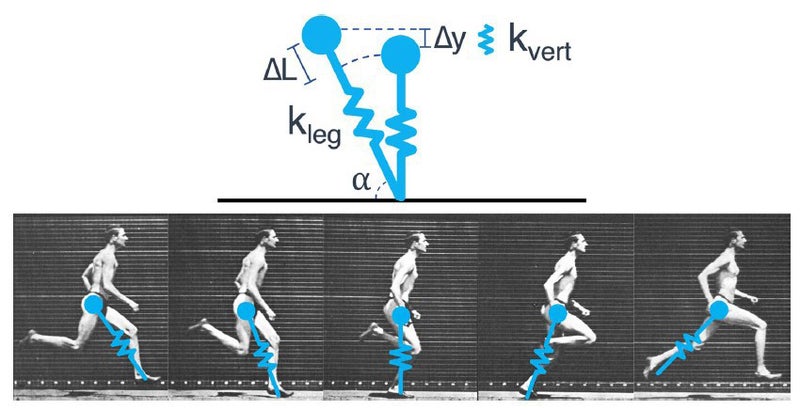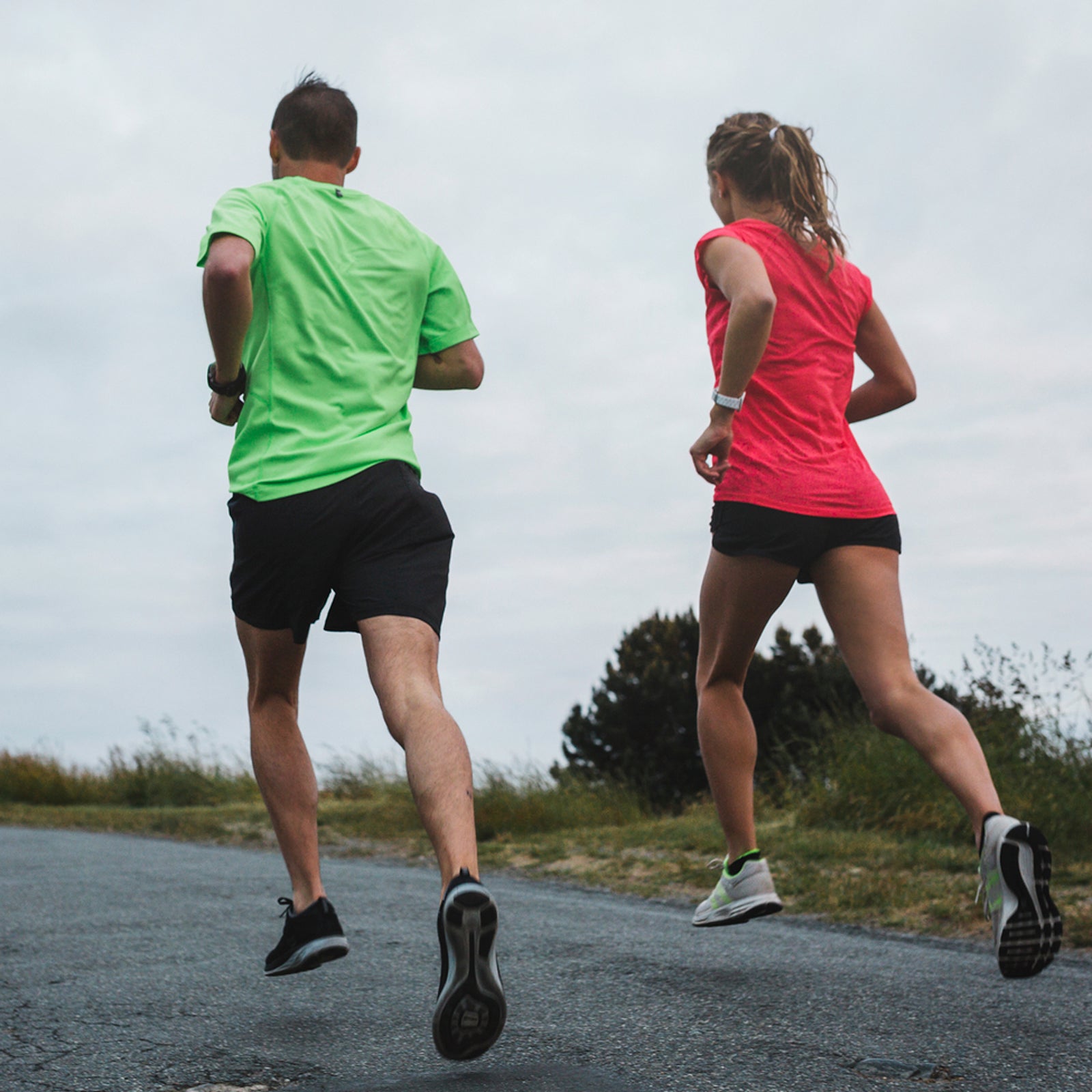Imagine trying to explain how to run to someone who’d never done it before—the incredibly complex sequence of forces and joint angles and muscle contractions that you need to coordinate in exactly the right order. That complexity is why it’s really hard to build a robot that can run on two legs, and it’s also why attempts to improve running form by tweaking a joint here or an angle there have generally backfired.
But that doesn’t mean that some people don’t run objectively “better” than others. takes a more holistic approach to evaluating running form, comparing some of the greatest runners in the world to their merely good counterparts. Instead of worrying about exactly where the legs are or what the arms are doing, the analysis basically models each runner as a pogo stick—what’s known in the biomechanics world as the spring-mass model. Here’s what that simplified pogo-runner looks like, which is basically a ball attached to a spring attached to the ground:

There are only a few parameters in this model. The angle at which the spring hits the ground, α, tells you how vertical the runner’s body position is. The amount that the spring compresses with each stride depends on the spring’s stiffness and how much force is applied to it. It turns out that’s all you need to extract some useful insights.
The lead author of the new study is , an elite ultrarunner and postdoctoral research fellow working with Ron Zernicke at the University Michigan Performance Research Laboratory, whose earlier work on running cadence in ultramarathoners I wrote about here. This time he studied milers. Why? Because (as I noted earlier this month) milers possess the ultimate combination of speed and endurance, and as a result cover a very wide range of speeds in their training. If you want to study how running mechanics change as you accelerate from ten-minute miles to sub-four-minute-mile pace, middle-distance runners are your best bet.
For this study, Burns recruited ten world-class male runners with average personal bests of 3:37.3 for 1,500 meters and 3:54.6 for the mile, and compared them to ten well-trained runners with bests of 4:07.6 and 4:27.4. They all ran a series of tests on a force-measuring treadmill, with four-minute bouts at the slower speeds and 30-second sprints at the faster speeds, enabling Burns and his colleagues to calculate the properties of each runner’s notional pogo spring.
The overall conclusion? “The elite runners had a distinctly different relationship with the ground,” Burns explained in an email. Specifically, they spent less time on it (a shorter ground contact time for each stride at a given speed) and more time in the air (a longer flight time between strides). They also applied greater force to the ground with their foot strike, and oriented that ground force more vertically rather than horizontally. Finally, they had stiffer springs—not in the sense of a specific joint or tendon that was harder to stretch or compress, but in the overall behavior of their legs and body working together as a system.
(There are some other nuances in the data that I can’t do proper justice to here. One is how all the variables changed across different speeds. For example, the elites ran with greater vertical stiffness, but they also increased their stiffness more as they accelerated to higher speeds, so the difference was greatest at their race pace. The elites also had less stride-to-stride variability in most of the parameters, an observation that probably reflects a greater level of skill and expertise in their movement patterns. You can read more in the journal article, which is .)
It’s worth pausing here to unpack what it means to say that a runner has stiffer springs, or runs with more stiffness. I tried to pester Burns into revealing what the secret of elite stiffness might be. Is it the structure of their tendons? How much they bend their knees? How strong their leg muscles are? “Yes,” he replied, “maybe all of those, or some of those, or none of those!” (Thanks for nothing, Geoff.) The point, he went on, is that there are endless ways of combining the movements of our myriad body parts that might achieve the same effect, and changing one part of the system affects all the other parts. One runner who bends their knees more than another might flex their ankles less, or have stiffer tendons, or stronger muscles, and end up with the same stiffness.
The usual approach to stride analysis looks at these individual components to search for patterns, but there’s so much variability among runners that it’s impossible to determine what, say, the “correct” knee angle is. By instead zooming out and looking at the overall spring-mass behavior, we can pick out these patterns that distinguish great runners from good ones. That doesn’t tell us which individual components are responsible for these holistic patterns, so the takeaway isn’t tips like “Relax your elbows and take shorter strides.” Instead, Burns suggests, you should aim to alter the overall characteristics of your running stride by stressing the system as a whole: “Cook with the ingredients that these elite runners use: intervals, hills, sprints, plyometric drills, running on varied surfaces, and maybe even lifting some heavy objects.”
The question lurking in the background is whether these traits are born or made. The runners in the control group were decent college runners, so they had all done interval training and hills and plyometrics and so on, but not with the rigor of the elites. Whether the control runners could ever, with sufficient training, acquire the pogo-stick characteristics of the elites is an open question. But there’s no question they can improve on their current state, Burns says: that characteristics like leg stiffness do respond and adapt to training.
To Burns, this is an argument in favor of monitoring your biomechanics, which can now be done with the high-speed camera on your smartphone. For example, he recommends a $14 , developed by Spanish sports scientist , which spits out your ground contact time, flight time, maximum force, and leg (i.e. spring) stiffness. What happens to those parameters after a ten-week program of hill training? Or when you’re returning from injury? Once you’ve established your own baseline values, you can tell whether you’re progressing or regressing.
“To think that we can’t learn from these differences would assume that they’re entirely intrinsic to these elites—that they’re pre-determined or unmovable,” Burns says. “But I suspect the fundamental driving thesis for most readers of �����ԹϺ��� and most endurance athletes is that, to some extent, we can always change and move the dial towards something better.”
For more Sweat Science, join me on and , sign up for the , and check out my book .


